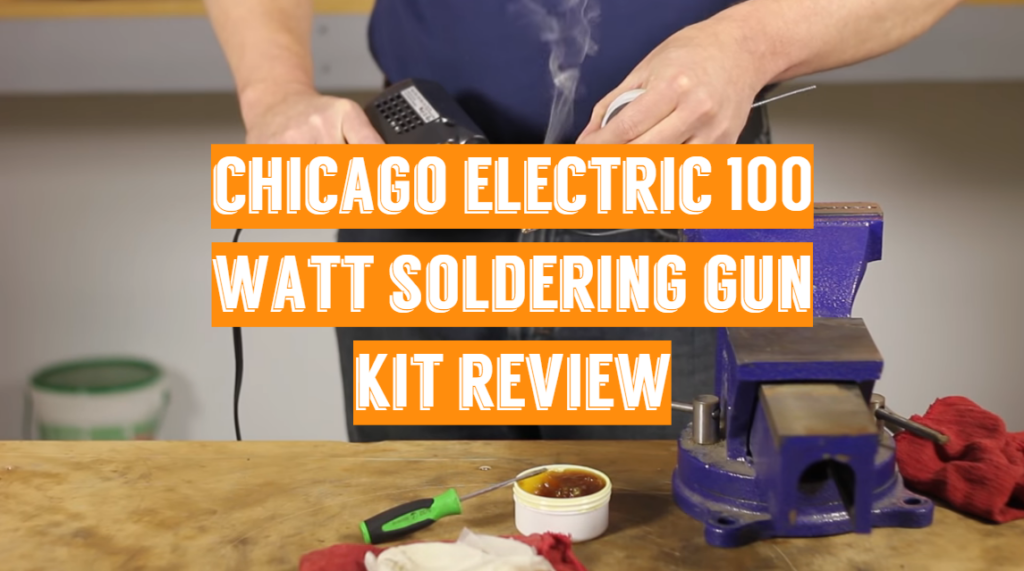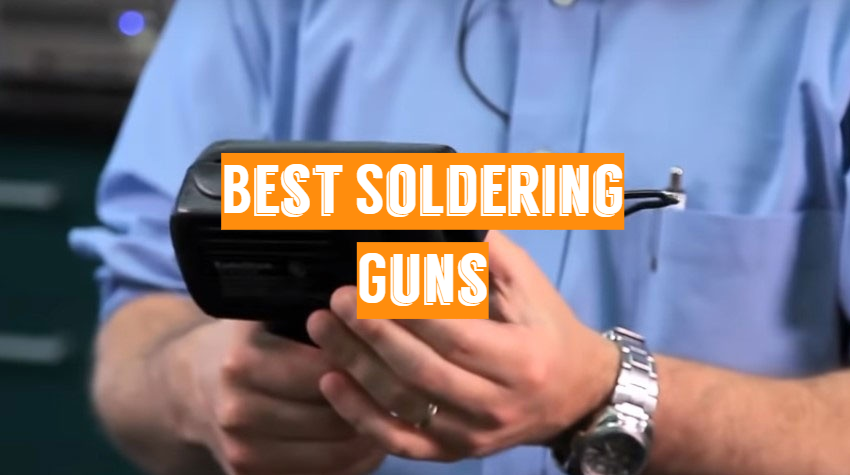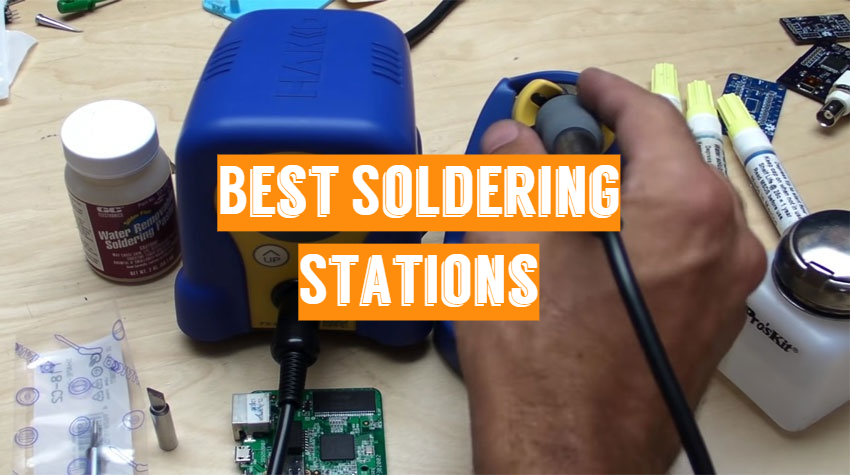This 100-watt Chicago Electric soldering pistol heats up with a trigger pull. In 8 seconds, the heavy-duty heating element is ready for soldering. The device can heat up to 1175F. The built-in illumination makes it easier to see pieces when you are welding. Tips may be substituted, meaning you still have a new contact point.

- Wattage (watts): 100
- AC Volts: 120
- Temperature range (deg F): 1175° F
Besides the gun itself, the specific kit includes:
- 3 different soldering tips;
- 10G soldering flux;
- A storage case;
- 10G soldering reel;
At 15-Fahrenheit temperature outdoors, the Chicago Electric 100W soldering gun operates. It could be a nice solution for outdoor soldering in winter.
The mix of replaceable tips to meet mission difficulties. It’s lightweight, easily heats up and quickly cools down. The soldering gun performs outstanding, much superior to a butane pistol or a soldering iron.
Performance
Although acetylene torches and more conventional welding methods are involved in most metal joining done on vehicles, these 100W soldering arms may be useful for smaller activities. For any reliable motor repairs that may be influenced by the strain built up in an engine, the metal picked in soldering is too soft.
A few examples of how you may need the Chicago Electric 100-Watt soldering gun:
- Different jewelry jobs;
- To meld any electronic solder;
- For moderate plumbing jobs;
- To solder in dark places;
- To work with brazing rods and mixed alloy solder;
- To tin braided wire;
- To cut Plexiglass;
- Can cope with small wiring jobs and electrical components;
- For wood-burning;
- For stained glass jobs;
Recommendations for users:
- Set the unit away from any flammable products on a fireproof workbench and connect the power cord into an electrical socket;
- Until the tip heats up, click the trigger;
- Around the whole edge, add an appropriate amount of rosin-core solder to melt. Wipe with a piece of clean cloth over the edge until the tip is smooth and shiny;
- Brush the workpiece on solder flux, as needed. Position the tip to be soldered by the joint, wiring splice, or metal;
- Apply solder, not the tip, to the wire splice or metal to be soldered. If the splice or metal is hot enough, the solder can melt and allow it to flow inside the splice or between the surfaces of the metal.
- Remove the tip and release the button until the solder has flowed across the full wire splice or metal surface;
- Switch off the tool to stop injuries and unplug after each use. Cleanse, then store the instrument out of the control of children indoors;
Before every use, check the condition of this tool. Check it for:
- Misalignment of moving parts;
- Loose hardware;
- Broken or cracked parts;
- Damaged cord or wires;
Upon application, heat the soldering tip once more and cover the tip with a tiny amount of rosin-core solder. Wipe yourself dry with a towel. This would leave the tip ready for usage and clean.
Pros and Cons of Chicago Electric 100 Watt Soldering Gun Kit
Pros
- Heats up completely in 8 seconds;
- Cools down quickly as well;
- Has in-built LED lighting;
- The great temperature range;
- Limited 90-day warranty;
- Quite versatile;
- Good for heavy-duty tasks;
- Very affordable;
- Great gun grip;
- Auto shut-off;
- Good for soldering outdoors;
- Ready to use in just 8 seconds;
- Built-in LED light for clear viewing;
- Works with mixed alloy solder, brazing rods.
Cons
- A useless solder comes with this kit;
- Good only for beginners;
- Replacement parts are hard to find;
- Flimsy case;
- Not the best quality.
The gun heats up easily and, as it should be, soldiers, tidy, safe, and once. This could be a good starter kit. It comes with grease and solder, so you may start to work on your task right after unboxing.
The Buyer’s Guide
Do you want to buy a 100W soldering gun? Consider a few factors before buying:
Single unit or a kit?
You need a package if you’re going to deal with electronics. The key explanation here is that to get the job finished, you want tweezers, desoldering pumps and even different advice. They are all included in the box or, more specifically, in the kit. In other terms, you can get a standalone soldering gun and then just buy the components or you can get a set and automatically finish the search.
Design
You may pick between soldering irons and soldering weapons, first of all. Soldering guns that have a shape like a gun, except the tip is on the front. Like a stick style, soldering irons have straight, and they are a more affordable, older, and smaller choice.
A soldering gun is a more appropriate choice. It is easy to use, more realistic and looks much better. If you are planning on using it regularly, check for the ergonomic nature of the handle.
Power
The output of power is calculated in wattage which differs from 100 to 250 watts. More efficient versions will heat up quicker, solder can melt in less time, and be ready in seconds for the next job. For thinner wires and small electronic components, versions with lower power are used.
Those with a higher output of electricity can be used within a house for stronger wires and vehicles, bicycles, or wiring.
Adjustable temperature
There is an adjustable temperature for most soldering irons. It is in the region between 200 to 1000 degrees. If you want to weld something rapidly, a higher temperature is more enticing.
When you need to prevent damaging the surface of the board, a lower temperature is needed. To change the temperature, you may use the trigger or the dial.
Tips
Tips are what you should apply to your welding gun and something you’re going to use. Some devices are built for smothering, other tools – for cutting, and some are made for easy soldering.
This is helpful if you happen to get a 5-in-1 instrument. Bear in mind that the majority of soldering weapons come with 3 tips, but if desired, you can buy additional ones separately.
Lighting
Yes, when operating, you’ll need lamps. By lighting the workplace, they will support you to help you get a job completed with less time and a lot faster. These days, almost all Chicago Electric irons have LEDs and this is the best choice.
Heating time
The heating period is measured as a gap between being allowed to use it and plugging the soldering iron in. It differs from 6 seconds to 3 minutes. The shorter, the cooler. Obviously, you will finish a mission in less time and the instrument would be ready in less time for the next work.
Chicago Electric 100 Watt soldering guns vs Weller 100 Watt soldering guns
First of all, the Chicago Electric 100W soldering gun costs less than $30, while an average Weller 100W soldering gun will cost you at least $60.
The Weller guns are also a bit heavier, though, it is a matter of preference.
The build quality of the Chicago Electric tools is worse than any Weller instruments.
Also, due to the worse build quality, the Chicago Electric soldering guns may wear off the tips faster than Weller tools.
Except for battery/ground cables, the Weller 100-watt gun is perfect for anything in the automotive field. The Chicago Electric guns won’t cope with such tasks too but will do better with small electronic components.
If you need to solder small wires, consider using the Chicago Electric soldering gun instead of more powerful Weller tools.
Also, the Weller guns are designed mostly for professionals and experienced DIYers, while any Chicago Electric soldering guns will do only for beginners.
FAQ
How hot a 100-Watt soldering gun should be?
On average, a 100-Watt soldering gun may heat up to 1000 degrees Fahrenheit. This particular gun may heat to 1175F.
Do you require flux to solder with the Chicago Electric 100-Watt soldering gun?
When soldering, do you need to use flux? Yes, you need to use flux while forging circuit boards or other electrical/electronic equipment. Fortunately, there is an intrinsic center of flux in nearly all solder types for electronics use, so you typically do not need to incorporate any.
Is it safe to use petroleum jelly with this tool?
Yes, it is safe to use petroleum jelly as a soldering flux alternative.
Can you use a 100W soldering gun for Arduino projects?
For both 20W and 100W, they have been welding for a while now and they both have somewhat different applications. For smaller jobs and finer parts, the 100W is not suggested – it is far too efficient. Security is proportional to knowledge and care of most soldering procedures. You’ll require a temperature-controlled iron if you really get into this material.
What is more cost-effective: a 100W soldering iron or 100W soldering gun?
A soldering iron or a gun of 100 watts can be a very powerful tool for any heavy-duty soldering operation.
In 1946, the Weller company developed the first soldering gun. It was very easy to work, pull the trigger and the tip heats up fairly fast, remove the trigger, and very quickly the tip cools off. It is heated on demand (trigger), so energy (watts) is only used as desired.
From the moment it is plugged in to the power source, the soldering iron (without the temperature control feature) is on and continues to use power until it is unplugged. To retain the fixed temperature, temperature-regulated soldering irons can constantly turn on and off.
The 100W soldering iron would probably require power and would thus be more costly than the soldering gun to work. Even opposed to a 25-watt soldering iron, it will be less risky to use either of the 100W instruments, since it just heats up (very quickly) when the lever is pulled.
Video Review: How to Use a Soldering Gun : Lawn Care & Power Tools
Final thoughts
If you seek a powerful 100W soldering gun, consider picking this Chicago Electric tool. It may cope with many soldering tasks, being especially good thanks to its price point. However, the kit can’t be by any means recommended to professionals, it is a solid starter kit.




As a professional, you can use this soldering gun for any project. It is great for jewelry jobs, as it’s easy to meld anything together with the electronic solder that came along with it. You can also solder in dark places and work with brazing rods and mixed alloy solder. The Chicago Electric 100 Watt Soldering Gun Kit works well on small wiring jobs and electrical components as well as wood-burning or stained glass projects.